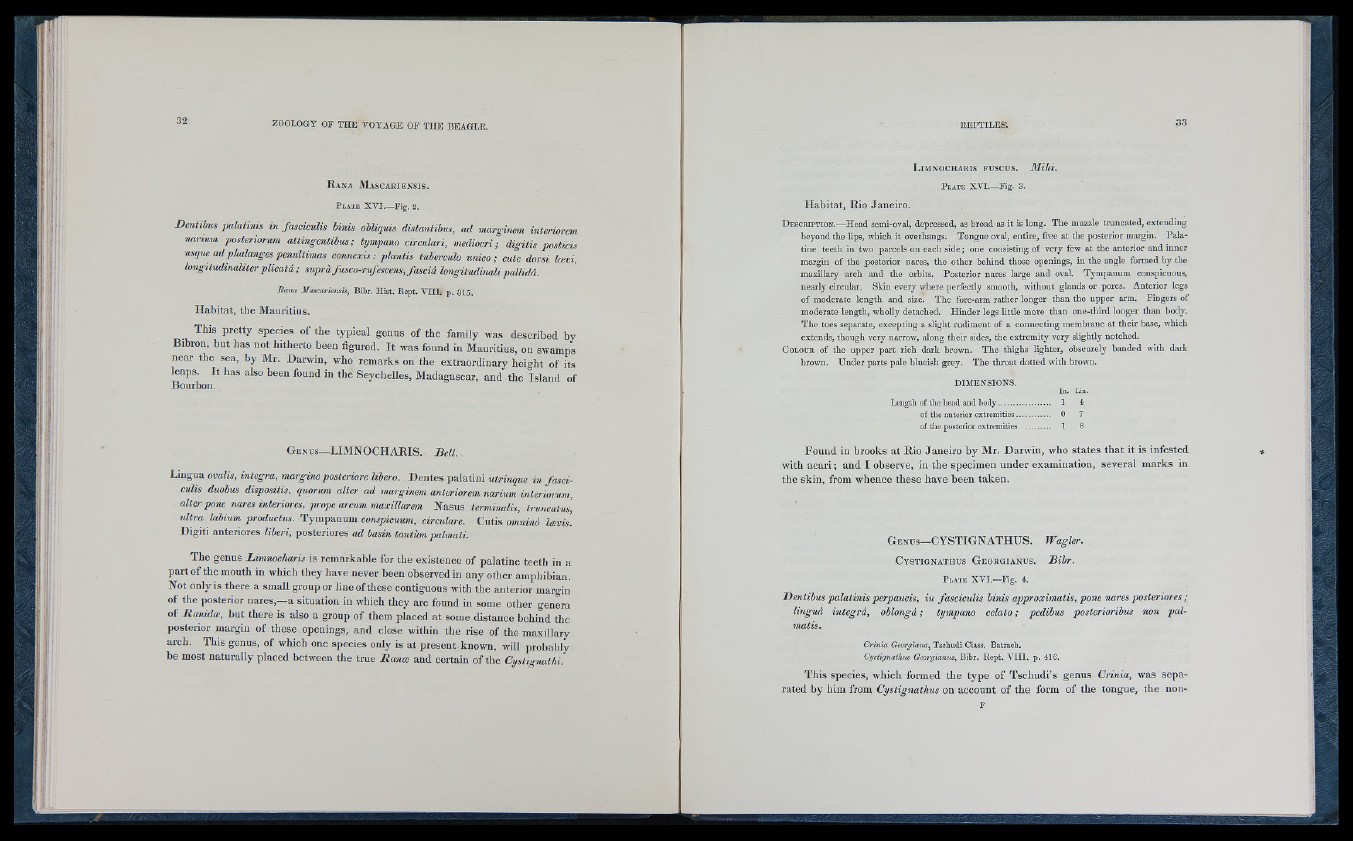
R a n a M a s c a r ie n s is .
P late X V I.— F ig . 2.
-Dentihus palatims in fascicuUs Unis obliquis distantibus, ad marginem interiorem
narium posteriorwm attingentihus; tympano circulari, mediocri; digitis posticis
usq,K ad phalanges penúltimas connexis : plantis tubérculo unico ; cute dorsi lavi,
longitudinalitèr plicatá ; suprà fusco-rufescens,fasciá longitudinali pallidá.
Rana
Habitat, the Mauritius.
Bibr. Hist. Rept. V i l i ; p. 315.
This pretty species of the typical genus of the family was described by
Bibron, but has not hitherto been figured. I t was found in Mauritius, on swamps
near the sea, by Mr. Darwin, who remarks on the extraordinary height of its
leaps. I t has also been found in the Seychelles, Madagascar, and the Island of
Bourbon.
G e n u s-L IM N O CH A R IS . Bell.
Lingua ovalis, integra, margine posteriore libero. Dentes palatini utrinque in fasci-
culis duobus dispositis, quorum alter ad marginem anteriorem narium interiorum,
alter pone nares interiores, prope arcum maxillarem Nasus terminalis, truncatm,
ultra labium productus. Tympiirmm conspicuum, circulare. Cutis ommred Items.
Digiti anteriores liberi, posteriores ad basin tantum palmati.
The genus Limnocharis is remarkable for the existence of palatine teeth in a
part of the mouth in which they have never been observed in any other amphibian.
Not only is there a small group or line of these contiguous with the anterior margin
of the posterior nares,—a situation in which they are found in some other genera
of Ranidte, but there is also a group of them placed at some distance behind the
posterior margin of these openings, and close within the rise of the maxillary
arch. This genus, of which one species only is at present known, will probably
be most naturally placed between the true Rana; and certain of the Cystignathi.
L im n o c h a r i s f u s c u s . 3Tilii.
P late X V I .-F ig . 3.
Habitat, Rio Janeiro.
D e s c r ip t io n .'—H e ad semi-oval, d epressed, as broad as it is long. T h e muzzle tru n c a ted , e x te n d in g
beyond th e lips, which it overhangs. T o n g u e oval, en tire , free a t th e posterior margin. P a la tin
e te e th in two parcels on each s id e ; one consisting o f very few a t th e a n te rio r a n d in n e r
margin o f th e p o s te rio r nares, th e o th e r b e h in d those openings, in th e angle formed by the
maxillary arch a n d th e orbits. P o s te rio r nares large a n d oval. T ym p an um conspicuous,
n e a rly circular. Skin every where perfectly smooth, with o u t glands or pores. An terio r legs
o f modera te len g th a n d size. T h e fore-arm ra th e r longer th a n th e u p p e r arm. F in g e rs o f
m oderate len g th , wholly detached. H in d e r legs little m o re th a n o n e -th ird lo n g e r th a n body.
T h e toes separate, ex c ep tin g a slig h t ru d im en t o f a co nne cting membrane a t th e ir base, which
ex ten d s, th o u g h very narrow, along th e ir sides, th e e x trem ity very slightly notched.
C olour o f th e u p p e r p a r t rich d a rk brown. T h e th ig h s lig h te r, obscurely b an d e d with dark
brown. U n d e r p arts pale blueish g re y . T h e th ro a t d o tte d w ith brown.
DIMENSIONS.
la . Lin.
Length of the head aud body 1 4
of the anterior extremities................. 0 7
of the posterior extremities ............ 1 8
Found in brooks at Rio Janeiro by Mr. Darwin, who states th a t it is infested
with a c a ri; and I observe, in the specimen under examination, several marks in
the skin, from whence these have been taken.
G e n u s— CYSTIGNATHUS. Wagler.
C y s t i g n a t h u s G e o r g i a n u s . Bibr.
P late X V I . - F ig . 4.
Dentibus palatims perpaucis, in fasciculis binis approximatis, pone nares posteriores;
linguá integra, oblonga; tympano celato; pedibus posterioribus non pal-
Crinia Georgiana, Tsclmdi Class. Batrach.
Cystignathus Georgianus, Bibr. Rept. V I II. p. 416.
This species, which formed the type of Tschudi’s genus Crinia, was separated
by him from Cystignathus on account of the form of the tongue, the non